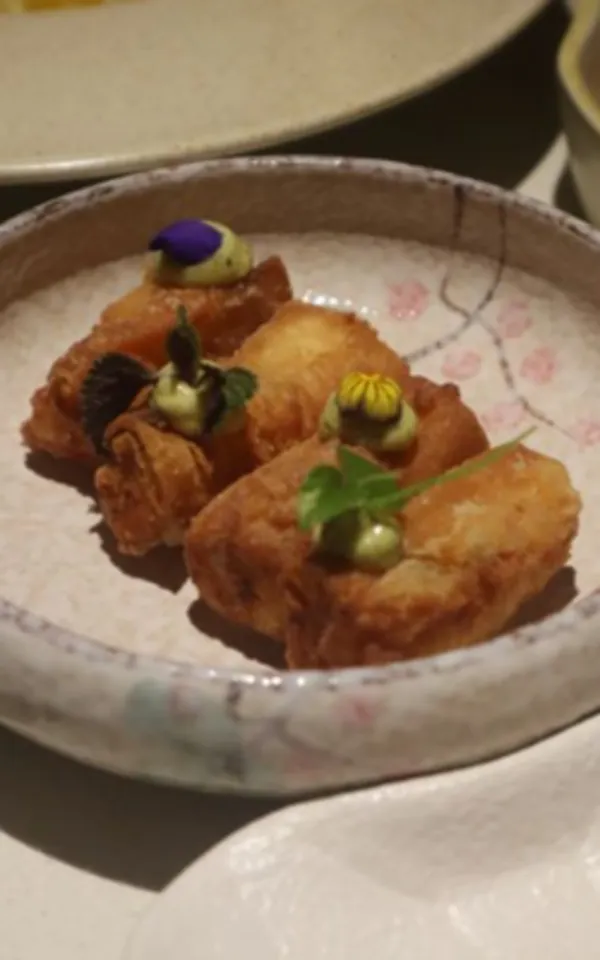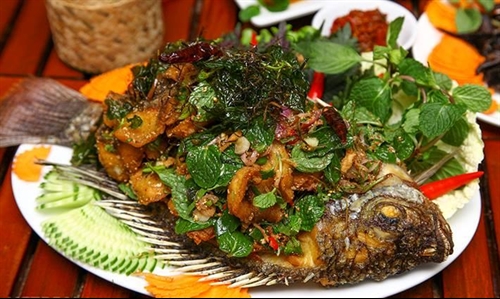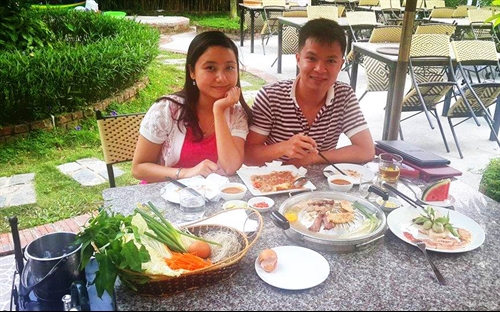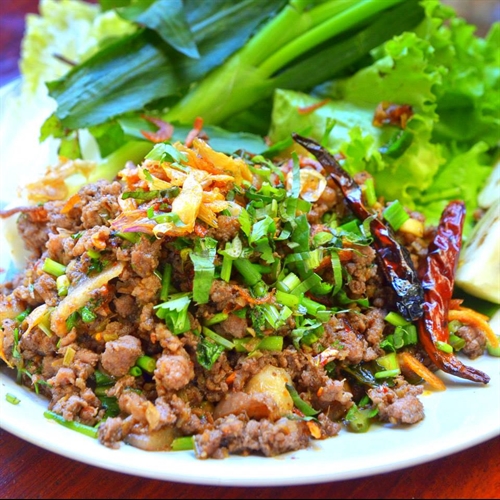 Restaurant Review
Restaurant Review

This is not just a restaurant, but an oasis for experiencing the cuisine and music of Laos
 |
| Lao minced meat salad: In this larb, fish is sliced, fried roughly and mixed with herbs and spices, especially padaek (Lao fish sauce). VNS Photos Minh Thu |
By Minh Thu
When I came to the yard to enter Laos Restaurant, I heard Phe Xai Euy, a popular traditional song.
“Sabaidee,” the waiter said, welcoming guests with a friendly smile. This is not just a restaurant but a Laotian cultural oasis, where visitors can experience a taste of Laos through its cuisine and music.
The restaurant impressed me at first sight. Tables are arranged between trees in a spacious garden. While waiting for the food, my son ran around excitedly and played with the available toys.
For diners who haven’t tried Lao food, waiters will introduce the highlights of the menu and help you select dishes. Many dishes are hot and spicy. Waiters describe just how spicy dishes are. Gourmets can request less or more chili.
First we tried Tam Maak Hung (Green Papaya Salad), Lao speciality. This veg salad is made of unripe papaya, eggplant, and peas. These ingredients are soaked in a spice mixture, creating a balance of sour, hot, salty and sweet tastes. The salad is crunchy and has a fresh flavour.
Another must-try Laotian dish is larb (also pronounced as laap), a minced meat salad regarded as the national dish of Laos. Larb is most often made with chicken, beef, duck, fish, pork or mushrooms, flavoured with lime juice, padaek and fresh herbs like coriander and galanga. Khao khua (roughly toasted rice powder) is also a very important component of this dish. The meat can be either raw or cooked; it is minced and mixed with chili, mint, and sometimes assorted vegetables.
Fish is sliced, fried roughly, and mixed with herbs and spices, especially padaek. Padaek fish sauce is a traditional condiment made of pickled or fermented fish. It is a thicker, seasoned fish sauce which often contains chunks of fish. The dish is served with sticky rice and raw vegetables.
Khao Chow, or sticky rice, is kept in a capped tiny bamboo basket. How lovely! Just like the sticky rice I ate in Vientiane long ago.
Fish larb costs VNĐ150,000 for a 500g fish. The sliced fish presentation involves the whole fish, including tail and head. The taste was so delicate that I thought I could eat a double portion. But I restrained myself to save room for other dishes.
“Larb means ’luck’ in the Lao language,” said Khamnoy Soukkhavong, the restaurant owner. “This is a traditional dish. It’s served to guests for feasts on special occasions. The ingredients to make it are not expensive or rare. But the way we mix the ingredients makes it special.”
He’s right. Laotians skillfully mix the ingredients together to make larb a symphony. Larb is an exquisite harmony of ingredients.
For a filling dish which is also a crowd-pleaser, order sindat, a Lao-style hotpot. The waiter prepared our hotpot for us. It was served with a small charcoal burning stove with a lip, allowing a metal domed griddle to sit perfectly horizontal. The waiter poured broth around the domed griddle. Then he brought us a plate of thinly sliced beef, pork and chicken, and a basket of vegetables, mushrooms, noodles and eggs.
Sindat is a combination of a Japanese hotpot and Korean BBQ. We were wowed. Leafy vegetables, noodles, mushrooms and eggs go into the broth. Meat and pork fat are grilled on the dome-shaped griddle.The pork fat greases the griddle as the meat cooks. All the drippings of the meat go into the broth, making a delicious soup.
At this restaurant, food can be dipped in a sauce that gourmets can customise to taste. Peanut sauce is the base. To the peanut sauce, you can add chopped garlic, fresh chilies, and lime juice, all of which are a savory complement to grilled meat.
There are many other Lao specialities on the menu, including fried green moss, crispy pork skin, and dried beef. All of them tempted me. But I decided to try them next time.
The culinary experience is complete with Lao beer, which was created in 1973 and named "Asia’s best beer" by Time magazine in 2004. Lao Beer is made with rice, as well as malt, giving the drink a light, exotic flavour.
What I like least about this restaurant: they don’t serve dessert. I hope that by the next time I visit, Soukkhavong will add Lao sweets, such as Khao Nieow Ma Muang (sticky rice and mango) and bananas in coconut cream, which I ate in Laos and can’t forget. VNS
Laos Restaurant
Address: 110 Cầu Giấy, Quận Cầu Giấy, Hà NộiTel: (04) 66828327 - Hotline: 0982182290Facebook: nhahanglao, laorestaurant
Open: Monday-Sunday
Hours: 8am – 11pm
Comments: Large indoor and outdoor dining areas. Garden. Nice English-speaking staff. Attentive service. Authentic Laotian cuisine.
 |
| Green papaya salad: Tam Maak Hung salad is crunchy and preserves its fresh flavour well in this dish. |
 |
| Foodie delights: Gourmets enjoy sindat, the combination of Japanese hotpot and Korean BBQ. |
 |
| Beef larb: The meat can be either raw or cooked; it is minced and mixed with chili, mint and, optionally, assorted vegetables. |